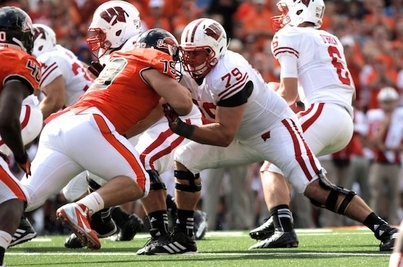By Mike Kuchar
Senior Research
Researchers' Note: You can access the raw data - in the form of graphs - from our research on the one-back power game: Click here to read the Statistical Analysis Report.
 Ah…the battle tested Power O. It rivals the veer option as perhaps the most utilized offensive scheme in football. It’s tried and true – tracing back from the days when Woody Hayes fed the ball to Archie Griffin behind a stout fullback and those dominate offensive lines at Ohio State. "Four yards and a cloud of dust," was not just a mantra but an offensive creed to live by. Even nowadays it’s rare to break down five minutes of game tape without seeing some remnants of the play show up at least a handful of times.
Ah…the battle tested Power O. It rivals the veer option as perhaps the most utilized offensive scheme in football. It’s tried and true – tracing back from the days when Woody Hayes fed the ball to Archie Griffin behind a stout fullback and those dominate offensive lines at Ohio State. "Four yards and a cloud of dust," was not just a mantra but an offensive creed to live by. Even nowadays it’s rare to break down five minutes of game tape without seeing some remnants of the play show up at least a handful of times.
But, it’s the form of the scheme that we see changing. As coaches, we have all gotten frustrated banging our heads against the wall trying to run the scheme against an 8 or 9-man box. It seems as soon as you put two backs on the field, defenses will play some sort of eight-man front canceling gaps. But, the play is too aesthetic and too authentic to be dumped – its smash mouth football at it’s finest. So how can you run the scheme without comprising its integrity to the game or its downhill style?
As researchers we wanted the answer, so we searched to find it. The coaches we spoke with believed that instead of feeding the defense what it wants (by lining up and running right at them) they are finding ways to spread the field by eliminating that fullback-type and still keep the structure of the play the same. We’ve seen Auburn offensive coordinator Gus Malzahn "ride" the concept out of shotgun sets to a national championship using Cam Newton as his weapon. We’ve seen Rashard Mendhall of the Pittsburgh Steelers use the scheme to gash the rest of the AFC for over 1,200 yards this season during their race to Super Bowl. So while it is possible to run the scheme with one-back, in order for your production to be probable, we’ve found you’ll need to conquer these certain problem areas.
Case 1: Creating Conflict With the Play Side Defensive End Without uncertainty, we’ve found that it’s that pesky EMLOS (end man on line of scrimmage) that could cause the biggest headache when running the scheme. We realize that plenty of teams have now started to adjust the scheme by running it into the A/B gaps (which we will explain later) but if you don’t get the proper hat on that edge player the play could be squashed. We’ve found that how you block that player most likely depends on where he lines up. For all intents and purposes, we’ll use the following numbering system to declare his alignment:
- 7-technique: inside eye of the tight end
- 6-technique: head up the tight end
- 9-technique: outside eye of the tight end
Since we’ve found that the 7-technique causes the most concern, we will start there. A gap scheme by nature, the power play is designed to "create a wall" by using down blocking from the front side of the play. Coupled with a back-side puller that kicks out (can be a guard or an H-back) the play is designed to be run outside the down blocks and inside the kick out block. It was Jim Tressel, the head coach at Ohio State, who used to tell Maurice Clarett to get "cheek-to-cheek," meaning split the butt cheeks of the kick out blocker and the widest down blocker and run the ball in the alley. While Tressel may be brave enough to tell a talented back like Clarett where to run the ball, most of the coaches we spoke with aren’t as specific with their directives. Plus, defensive ends now are taught to wrong-arm all blocks to push the ball to the perimeter, which can make a kick out block next to impossible.
One way to diffuse this problem is simply to block down on the 7-technique with the tight end and eliminate any kick-out scenario. Our research found that 50.7% of coaches teach their tight end to do exactly that. Sam Pittman, a 26-year coaching veteran who is now the offensive line coach at the University of North Carolina, made his money with the likes of running back Michael Turner and Garrett Wolfe running the scheme. Pittman makes it real simple – he has the tight end handle the defensive end…period. No chip and release. No pass set. Just plain 'ol block him. "He (tight end) is responsible for C gap and when we teach the power scheme gaps always override people," says Pittman. The main coaching point is for the tight end to reach block the 7-technique by getting his back-side shoulder down and cutting him off from the gap.









